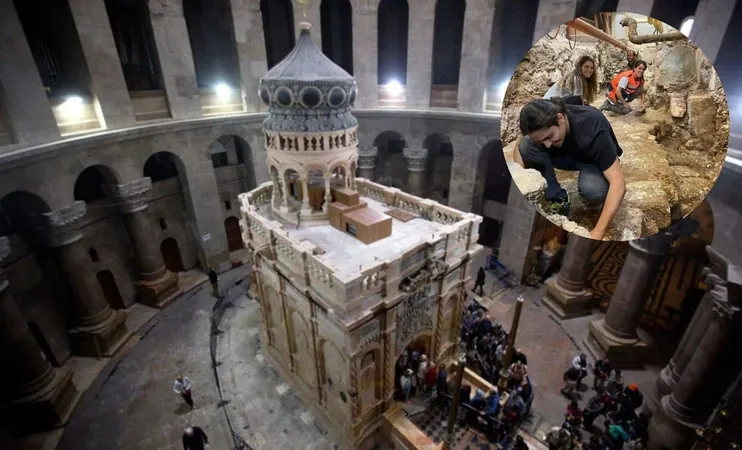
Ancient Garden Unearthed at Jesus Christ’s Tomb: A Major Archaeological Breakthrough!
2025-04-04
Author: Wai
In an astonishing archaeological breakthrough, experts have uncovered remnants of an ancient garden beneath the Church of the Holy Sepulchre in Jerusalem, precisely aligning with descriptions from the Gospel of John. This discovery, reported by The Times of Israel, unveils a historical and biblical landscape that has lain hidden for hundreds of years, enhancing our understanding of this sacred site long associated with the crucifixion and burial of Jesus Christ.
Traces of Olive Trees and Grapevines Discovered
Led by Prof. Francesca Romana Stasolla from Sapienza University of Rome, the archaeological team identified evidence of olive trees and grapevines through meticulous archaeobotanical and pollen analysis. These findings lend credence to the verse from the Gospel of John: “Now in the place where he was crucified there was a garden; and in the garden, a new sepulcher, wherein was never man yet laid” (John 19:19-20). The foliage suggests that the area served agricultural purposes prior to the church’s construction.
This tangible piece of evidence brings the biblical narrative of the garden tomb to life, affirming the historical integrity of the Gospel’s portrayal of the environment relevant to Jesus’ time. Thus far, the evidence points to a pre-Christian era, though radiocarbon dating of the plants is still on the horizon to confirm their age precisely.
Historical Context and the Impact of Roman Urbanization
The layers of history at this site provide intriguing insight into its developmental trajectory. Prof. Stasolla explains that the site was incorporated into Aelia Capitolina, the Roman city built under Emperor Hadrian in the 2nd century CE. “During the time of Jesus, the site still functioned as an agricultural landscape and wasn’t part of the Roman urban grid just yet,” she elaborated. This distinction is vital as it marks the transformation from agricultural land to an essential component of Roman urban infrastructure.
Additionally, archaeologists have uncovered Iron Age artifacts, including pottery and lamps, indicating that this area thrived long before Christianity emerged. These artifacts paint a detailed picture of daily life in Jerusalem, framing the later Christian importance of the site.
Excavation and Restoration Efforts Underway
This excavation forms a crucial aspect of a comprehensive renovation project at the Church of the Holy Sepulchre, which has seen several phases of destruction and restoration throughout history. Notably, it represents the first major overhaul since a fire ravaged the church in 1808. Prof. Stasolla emphasizes the collaborative effort among various religious communities that manage the church, including the Orthodox Patriarchate, the Custody of the Holy Land, and the Armenian Patriarchate.
“With the ongoing renovations, the religious bodies agreed to permit archaeological excavations beneath the floor,” she noted. This decision has catalyzed new archaeological revelations while adding depth to the already rich history encapsulated within the edifice. As excavations progress, care is being taken to maintain both the archaeological findings and the religious ceremonies that occur at the site.
Technological Advancements Paving the Way for Future Discoveries
While excavations continue, cutting-edge technologies are allowing researchers to better understand the historical narrative of the church. “We may not be able to see the entire church's excavated context all at once, but innovative technology is helping us piece together this historical puzzle in our laboratories,” Stasolla explained. “We are working on reconstructing the full narrative piece by piece, aiming for a comprehensive multimedia depiction of the site’s extensive history.”
As this groundbreaking work advances, more revelations about the historical and religious significance of the Church of the Holy Sepulchre are anticipated. The ancient garden's discovery not only piques scholarly interest but also inspires the faithful, providing a deeper connection to the roots of Christianity. Stakeholders and historians alike are watching with bated breath as this extraordinary excavation continues to unfold its secrets.




 Brasil (PT)
Brasil (PT)
 Canada (EN)
Canada (EN)
 Chile (ES)
Chile (ES)
 Česko (CS)
Česko (CS)
 대한민국 (KO)
대한민국 (KO)
 España (ES)
España (ES)
 France (FR)
France (FR)
 Hong Kong (EN)
Hong Kong (EN)
 Italia (IT)
Italia (IT)
 日本 (JA)
日本 (JA)
 Magyarország (HU)
Magyarország (HU)
 Norge (NO)
Norge (NO)
 Polska (PL)
Polska (PL)
 Schweiz (DE)
Schweiz (DE)
 Singapore (EN)
Singapore (EN)
 Sverige (SV)
Sverige (SV)
 Suomi (FI)
Suomi (FI)
 Türkiye (TR)
Türkiye (TR)
 الإمارات العربية المتحدة (AR)
الإمارات العربية المتحدة (AR)